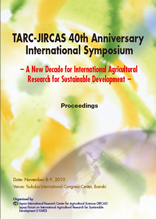CGIAR Reform - a new strategy and results framework to address emerging challenges and implications for advanced research institutes and networks

The origins of the CGIAR go back to 1943 and lie in the Mexico?Rockefeller Foundation
International Agricultural Program, a pioneering collaborative effort undertaken to address poverty
and food deficit in that country. The high yielding semi-dwarf varieties developed there increased
productivity significantly and subsequently transfer of technology to India resulted in the much
acclaimed “Green Revolution”. These early successes led to the establishment of IRRI (1960),
CIMMYT (1966), CIAT (1967) and IITA (1967), all predating JIRCAS whose 40th year of existence
we are celebrating this year.
The early successes in achieving major productivity gains in specific crops had a flip side to
the same coin - unintended consequences of inappropriate use (over or under) of fertilizer and
pesticides, degradation of soil health, water pollution, and loss of biodiversity. Increasing realization
of the need for a more sustainable resource use led to several new centres being set up to address these
issues, as well as to research and advocate for a more enabling institutional, policy and market
environment. Today there are 15 independent entities in the CG network.
The mission of the CGIAR continues to be to reduce poverty and hunger, improve human
health and nutrition, and enhance ecosystem resilience through high quality international agricultural
research, partnership and leadership. Past successes in agricultural research and technology adoption
have enabled a growing population to avoid mass starvation. Yet according to the FAO, over a billion
people out of 6.4 billion on the planet today go hungry every day and more than two-thirds of the poor
eke out a living from agriculture. In addition to population growth estimated to be 9.5 billion people
by 2050, persistent poverty, especially in South Asia and sub-Saharan Africa, and high rates of
malnutrition, new challenges include food price inflation, energy price volatility and global warming
and climate change causing shocks and stresses to ecosystems.
In the face of continuing and new challenges and following decades of underinvestment in
agricultural research and capacity, our ability to feed the world adequately is suspect. Hence the need
for a reformed and revitalized global public agricultural research system. The CGIAR collectively
represents only a small part of the global agricultural research agenda and budget but is an important
entity in the production of global public goods. In this context, a new strategy and results framework (SRF) is being developed for the effective implementation of the goals of the CGIAR. The SRF is
central to meeting the four principles of the CGIAR
?? A harmonized approach for supporting and conducting research through a dual structure,
which consists of a consortium of CGIAR centers and a new CGIAR fund
?? Management for results in accordance with the SRF and a portfolio of Consortium Research
Programs, that derive from the SRF
?? Effective governance and efficient operations for better provision and use of resources
?? Strong collaboration and partnership with and among funders, implementers and users of SRF
research as well as the external partners supporting the SRF
The SRF is intended to set common goals (in terms of development impacts), strategic objectives,
and results (in terms of outputs and outcomes) that are to be jointly achieved by the fund, the
consortium and the bilateral funders to the centers within a certain time frame.
In furtherance of the SRF, a portfolio of Consortium Research Programs is being developed
with the following criteria:
?? Strategic coherence and clarity of program objectives
?? Delivery focus and plausibility of impact
?? Quality of science
?? Quality of research and development partners and partnership management
?? Appropriateness and efficiency of program management
?? Clear accountability and financial soundness and efficiency of governance
The new strategy demands that the research yields results on the ground. While CGIAR’s core
competence is in cutting edge research, it will now work with regional and national research,
extension, and development partners to ensure that impact is carried through to the end user.
Complementary financing and support as well as efforts to build synergies with other international,
regional and national organizations are ways of achieving this goal. Strong external research partners
like JIRCAS have an important role to play in this regard and CGIAR would welcome long term
impact oriented collaboration.
| Date of issued | |
|---|---|
| Creator | Ganesan Balachander |
| Publisher | Japan International Research Center for Agricultural Sciences |
| Available Online | |
| Issue | 2010 |
| spage | 31 |
| epage | 37 |
| Rights | Japan International Research Center for Agricultural Sciences |
| Language | eng |
